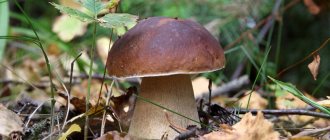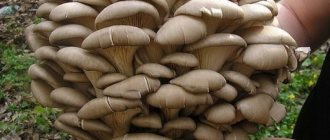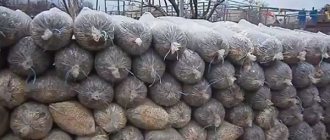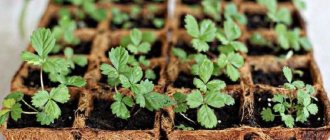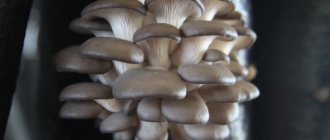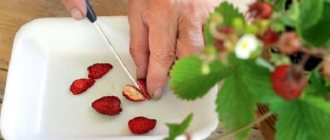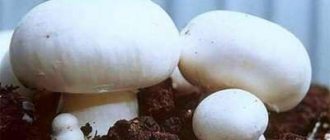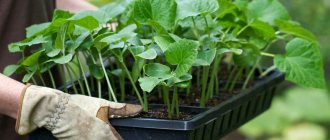The porcini mushroom is called the king of the forest, because even the youngest specimens look quite impressive due to their thick stem and fleshy cap. Unfortunately, in recent years fewer and fewer boletus mushrooms have been found in forests. This happens both due to climate change and due to the fact that some mushroom pickers do not collect correctly, which damages the mycelium and reduces yields.
If you don’t have time to go to the forest and look for boletus mushrooms, this does not mean that you will have to give up delicious wild mushrooms. You can easily grow them in your garden if you use the helpful tips and growing instructions provided in our article.
Overview of types of porcini mushrooms
- Spruce mushroom. The most common type. The hat is dark brown. The leg is thick and strong.
- Oak mushroom. The cap is brown, but not as dark as that of the spruce species. The leg is long and dense.
- Pine mushroom. The hat is chocolate-colored and can reach a fairly large size in diameter. The leg is also brown.
- Birch mushroom. The hat is light beige. The leg is quite long, barrel-shaped.
- Net mushroom. The size of the cap of this mushroom can reach a maximum of 30 cm. The surface has cracking in the form of a mesh.
- Semi-white mushroom. The cap is yellow or creamy-brown in color. The leg is elongated, long, cylindrical.
About boletus
Porcini is just one of the many names for porcini mushrooms. And they are called differently: chistoviki, cow, bebik, bugbears, expensive mushroom, belevik, capercaillie, and of course, boletus mushrooms. But no matter what they are called, they look almost the same:
- The boletus cap is almost always brown. With age, only the convexity of the cap of the mushroom changes: from the semi-cylindrical shape inherent in a small mushroom, it gradually turns into an almost flat shape. The average diameter of an adult mushroom cap is approximately 20 cm.
- The leg of the boletus is always whitish in color with vertical brown veins. At first it has the shape of a barrel, and with age it turns into a powerful, dense cylinder.
Beneficial properties of porcini mushrooms
Boletus contains protein, which is quite easily digestible. They are rich in vitamins and a large number of microelements: vitamins B, C, and D, carotene, riboflavin, potassium, calcium, iron, selenium, manganese, phosphorus, chromium. But they may not be useful to all people.
Young children should avoid eating mushrooms. And people with gastrointestinal problems and a tendency to allergies should eat them carefully, taking into account the characteristics of their body.
Economic feasibility of mushroom growing in Russia
If someone has a business idea to start growing mushrooms, then they need to calculate all the costs and future income. Let's consider the economic side of the question: is it profitable to grow porcini mushrooms in a greenhouse? There will be expenses to pay for a land plot with an area of, say, 500 m2 - 600 thousand rubles; construction of the building will cost 500 thousand rubles; approximately the same amount – 480 thousand rubles – is the cost of purchasing equipment. And if you add up the amounts of salaries, payments for utilities and transport services, administrative and marketing expenses, you will accumulate 240 thousand rubles. And you also need to buy porcini mushroom seeds. We add the cost of mycelium (it varies among different manufacturers) - the total initial costs for the business are approaching 2 million rubles.
The income from the greenhouse after harvesting will be at least 400 thousand rubles. But you can pick mushrooms two, three or more times per season (it all depends on the mycelium). The investment will pay off in just a few years, and the mushroom farm will begin to bring a stable profit to its owners.
You can sell fresh boletus mushrooms through markets, supermarkets and restaurants, process them (drying and freezing, salting and pickling) for catering and sale through retail chains.
Growing porcini mushrooms in the country
You can grow porcini mushrooms at home either in open ground directly under your own trees growing on the site, or in a closed place, for example, in a greenhouse or basement.
Recommendations for growing may differ depending on the location where boletus mushrooms will be planted. You must first prepare the substrate and material for planting.
The material used is mycelium or porcini mushroom caps. Mycelium can be obtained independently while going to the forest or purchased in a store.
Substrate
When wondering whether it is possible to grow porcini mushrooms yourself, be patient. Wherever you decide to grow mushrooms, it is better to initially prepare and collect the substrate necessary for growth. This is a specific composition that is sprinkled on the area prepared for the mycelium.
For each type of mushroom it is special and has different properties. For example, for whites, wood shavings, leaves, pine bark, straw, sawdust and husks are best suited. All these ingredients must be sterilized to eliminate the presence of harmful bacteria. Afterwards, the substrate must be buried in the mycelium, mixed with soil and watered abundantly.
Learning to plant porcini mushrooms in open ground
Perhaps the simplest and most effective method is to grow porcini mushrooms in your garden. Many connoisseurs of porcini mushrooms want to be able to collect porcini mushrooms not only in public places, such as forests, but also on their personal territory.
How to grow porcini mushrooms in the country is a question that worries many lovers of quiet hunting. The main difficulty is to achieve those necessary factors that will bring the conditions on the site closer to growth in a natural environment in the forest. That is, you need soil that is approximately the same as in the forest.
Ready-made soil can be purchased at the store. But in order to save money, you can prepare the necessary substrate yourself. For this you need dried grass and leaves of birch, oak or acorn, as well as spruce and pine needles. Dried moss is very good for a substrate.
All components must be dried, after which they must be crushed. Into the resulting mixture you need to add sifted sand, as well as dry clay (4 to 1). Next, let it brew in a dry and warm place for about two weeks.
Calculation part
Now you can calculate the main economic indicators.
Revenue
Let's decide on the introductions:
- 1 harvest is harvested in 2-2.5 months. It is proposed to accept a 2-month ripening period, but take a lower yield (in order to facilitate calculations).
- With proper sowing of the mycelium and creation of comfortable conditions for the development and growth of the mycelium, from 1 bag of substrate (weighing 30 kg) you can collect from 8 to 12 kg of porcini mushrooms. Let's take the yield equal to 10 kg per bag.
- 1 bag is placed on an area of 1 m². Provided that our proposed greenhouse is high (from 3 meters), the racks on which we display bags of substrate allow us to place them in 2 tiers (they will have enough light), as well as passages (33% of the usable area), we find that a total of 100 × (100% - 33%) × 2 = 134 bags (with substrate) will fit in a greenhouse with an area of 100 m².
- The price of porcini mushrooms on the market starts from 300 rubles. Let's take a pessimistic approach and accept a wholesale cost of 280 rubles/kg.
Then the annual revenue will be:
(12 / 2) harvest waves × (134 bags × 10 kg/bag) × 280 rubles/kg = approximately 2.25 million rubles.
Expenses
Initial costs:
- During the period of mycelium development (up to 12 days during the cycle), the temperature should be at 25°C and humidity 90%. During the growth period of the fungus, the temperature should be reduced to 16°C, and the humidity should be further increased to 95-98%. Such warm and humid conditions in our country cannot be observed every summer, so the inside of the greenhouse will definitely need to be heated and humidified. Doing this manually will not work - it requires technology, namely climate control. Moreover, it must be a powerful unit capable of heating a room with an area of 100 m². Its power must be at least 5 kW. And again, it is critical that the greenhouse has the most effective thermal insulation, otherwise the losses will literally “eat up” all the profit - you will transfer all the money to the electricity supply company. Powerful units that automatically control the climate in large rooms cost from 70 thousand rubles.
- Ventilation. To prevent heated air from being blown out and replaced by cold air, the ventilation system must have a heat exchanger. Technically, it is designed quite simply, and such a system (together with a 0.5 kW fan) costs from 10 thousand rubles.
Fine filters for purifying the blown air are not needed, since most likely no one will complain that boletus mushrooms have suddenly grown on their site, but it is strongly recommended to install a filter on the incoming air - this is another 25 thousand rubles per year.
- Fans to ensure air convection in the greenhouse. 3 units of 150 W each, costing 5 thousand rubles each, will be enough.
- The lack of room illumination can be compensated by installing LED strips - their emission spectrum is close to that of the sun, they consume little energy, and the entire farm can be equipped in this way for no more than 10 thousand rubles.
- To disinfect substrate material, you will definitely need a powerful steam generator, costing from 45 thousand rubles.
- In addition, in order to really do everything right and get the desired harvest in 2 months, it is strongly recommended to order a consultation with a professional agronomist. This is at least another 20 thousand rubles of one-time costs.
In total, the initial costs are:
Climate control (RUB 70 thousand) + ventilation without filter (RUB 10 thousand) + separate fans (RUB 15 thousand) + lighting (RUB 10 thousand) + steam generator (RUB 45 thousand) + consultation with a specialist (20 thousand rubles) = 170 thousand rubles.
Variable costs:
- The substrate is renewed before each “seeding” of the mycelium. It is better to buy a base for growing porcini mushrooms ready-made than to mix it yourself - there are too many components and too high precision is required when maintaining proportions. Leave yourself only the disinfection stage - this is much more realistic. 1 kg of substrate mixture costs 2 rubles. We need 134 bags of 30 kg each. Total: 134 mesh. × 30 kg × 2 rubles/kg = approximately 8 thousand rubles. expenses for the foundation before each wave, that is, approximately 50 thousand rubles per year.
- The mycelium also needs to be renewed every time. For 1 bag of substrate, 1 kg of mycelium is required, costing 2 thousand rubles/kg. The total per year is:
134 mesh × 1 kg × 2 thousand rubles/kg × (12/2) = approximately 1.6 million rubles.
This is the biggest expense item when growing porcini mushrooms.
- Electricity. Despite the fact that the project has a maximum total power consumption of 6 kW, this amount of energy will be consumed only at peaks. Therefore, it would be quite reasonable to take an average power of 4 kW into calculations:
4 kW × (12 months × 30 days × 24 hours) × 4.65 rubles/kWh = approximately 160 thousand rubles.
Total variable costs are:
Substrate mixture (50 thousand rubles) + mycelium (1.6 million rubles) + electricity costs (160 thousand rubles) + filter (25 thousand rubles) = 1.84 million rubles.
Fixed costs.
Growing porcini mushrooms in a greenhouse, at least within the framework of the project under consideration, is a business for dacha owners. It does not involve hiring labor; in addition, its organizers will have a decent amount of free time. In this regard, there are no costs not associated with the resumption of the technological cycle in the project.
Gross profit
We subtract variable costs from revenue: 2.25 million rubles. – 1.84 million rubles. = 410 thousand rubles
For this type of activity, high absolute levels of earnings are indicative, but at the same time very modest profitability of the production process (no more than 22%).
Taxes
Since we are talking about a summer cottage (where it is most logical to develop the project), this is a typical personal subsidiary plot (LPH), which, in accordance with Article 2, paragraph 4 of Federal Law No. 112-FZ of 07/07/2003, is completely exempt from paying taxes.
Profitability
Just to equip a suitable premises with the necessary equipment you will need 170 thousand rubles. In addition, the variable costs for providing the first two waves of the harvest (you won’t wait until you sell the first wave) will be:
- 8 thousand rubles × 2 waves = 16 thousand rubles. – on the substrate;
- 134 mesh × 1 kg × 2 thousand rubles/kg × 2 waves = 536 thousand rubles. – on mycelium;
- 4 kW × (2 months × 30 days × 24 hours) × 4.65 rubles/kWh = approximately 27 thousand rubles. – for electricity
Total 580 thousand rubles. With such investments, the project will be able to recover only in the second year (taking into account the fact that the estimated net profit is at the level of 400-410 thousand rubles for the year). As for the profitability of such a business, it is: 410 thousand rubles. / 580 thousand rubles × 100% = 71%.
Conditions for growing porcini mushroom:
- Use of trees available on the site. Spruce, pine, birch, and oak are good choices.
- It would be ideal if the dacha adjoins the forest.
- The recommended age of tree species is at least ten years.
- Mushroom material is planted in the spring.
Growing porcini mushrooms from mycelium
- Mycelium is available to those interested in the store. Or you can get it in the forest yourself by carefully digging out the mycelium.
- Around the tree that will be the symbiont, you need to remove a layer of soil, about 15 cm deep. This layer will still come in handy.
- Next, you need to put fertilizer on the prepared area: peat or compost.
- After which the pieces of mycelium are laid out in the prepared place no closer than 20 cm from each other.
- Finally, you need to use a layer of soil and carefully cover the mycelium with it.
- Then moisten the soil well at a rate of at least 20 liters for each tree. Because lack of moisture is detrimental to the mycelium.
- Carry out subsequent waterings as the soil dries out.
- The mycelium is protected from frost with moss and a layer of fallen leaves.
- In spring, this protection must be carefully removed with a rake.
How to grow boletus mushrooms
The next “forest dweller” beloved by many mushroom pickers is the boletus, which is also not difficult to grow on your own. The boletus, like any forest mushroom, for normal life and growth requires not a stump, but a living tree. From its root system, the mycelium absorbs carbohydrates and amino acids, giving the tree moisture, mineral compounds and natural antibiotics that protect it from pests and diseases. Therefore, it is extremely important that the mushroom zone is as close as possible to the natural habitat of the fungus.
As for the growing methods, they are the same as for boletus and boletus.
Reproduction by spores
Finely chop the overripe mushrooms and mix with one spoon of flour and gelatin powder. Pour the mixture into the moist soil under mature trees. The spores will germinate and form a mushroom root. After a few seasons you can expect the first harvest.
Growing from fruiting bodies
Select young boletus specimens, chop them and bury them in the top layer of soil next to the root system of the tree. The fruiting bodies form mycelium, and within a year, with good soil moisture, you can get a small harvest of 2-3 mushrooms.
Alternatively, in rainy weather, you can scatter small pieces of young mushrooms under the trees and cover them with fallen leaves. The formation of mycelium will be no less effective.
Mycelium transplant
This is a labor-intensive and not always effective process. Find a young tree in the forest with boletus under it. Carefully dig up the mycelium and transfer it to your site. Place it under a deciduous or coniferous tree.
Do not plant mushrooms next to fruit crops, as mushrooms form mycorrhizae and grow in symbiosis only with forest trees. Many mushrooms are even named after the trees near which they live (boletus, boletus).
Growing porcini mushrooms from caps
- For this method, you need to collect about ten fresh boletus mushrooms with fairly large caps from the forest. Mature mushrooms are needed, over-ripeness is allowed, but not spoiling.
- It is very important to remember under which tree the mushrooms found grew. Because if a boletus, for example, was found in the forest under a spruce tree, then the planting of spores or mycelium will need to be carried out under the spruce.
- You will need about ten caps, but only without legs. It is better to soak hats in rainwater.
- Next, add three to four tablespoons of water. spoons of sugar (based on 10 liters of water). You can use alcohol instead of sugar.
- The mushrooms remain soaked for a day and should be kept in a warm room.
- After this time, the caps are ground until smooth.
- Cut the soil around the tree where you plan to plant it. The depth is determined by the tree roots found.
- Next, the roots are watered with water containing spores.
- Afterwards, you need to cover the sowing area with a layer of soil that was cut off earlier.
- Watering should be according to the weather. In dry times it is quite abundant, since the mycelium does not tolerate drought.
- Straw can be used to maintain moisture.
This method takes longer than the first option in terms of obtaining results, since the mycelium of the porcini mushroom is grown, and not the use of ready-made material.
Farming
Champignons are very popular mushrooms, grown by large mushroom farms. But just like that, every summer resident can grow them.
You should know that this mushroom is unpretentious and when cultivating it, the planting location is not so important as the correct growing conditions. At the dacha, mushrooms can be grown in any suitable room or outdoors
First, let's talk about how to grow champignons in a greenhouse. But before that, it’s worth keeping in mind that there are several types of them. This is a white mushroom, cream and brown. The most demanding is the white variety, but the other two are less capricious, but produce much lower yields. And so, a greenhouse for porcini mushrooms is the most optimal place for growing, because maintaining the necessary conditions in it is quite simple.
The most important thing in planting mushrooms is the soil mixture, which must be able to pass moisture and air, be maximally saturated with nutrients, and the presence of carbon dioxide in it must not exceed acceptable standards, otherwise we will receive a substandard product. Forest turf is considered the best soil for a greenhouse. If it is impossible to create such soil, sawdust can be added to the existing soil.
For planting, mycelium is used, which we purchase at a seed store. Or you can cook it yourself. Finely chop old mushrooms that are unsuitable for food and add water at room temperature. Over the course of the day, spores will be released into the water. Before planting them, we warm up the greenhouse to a temperature of twenty-two degrees. And only then we evenly water the ground with the resulting liquid. Next, sprinkle with a centimeter layer of soil. For faster germination of spores, you can cover the sown soil with film.
Further care of the crops consists of maintaining a temperature that should not exceed twenty-six degrees Celsius, constant ventilation and moderate watering. Remember that the mushroom does not tolerate heat well, so do not allow it to overheat. After the first shoots appear, replace watering with spraying, twice a day. But we water abundantly once a week to prevent rot. Remove the ripe mushroom with its roots so as not to deplete the mycelium. We get a harvest several times during the season.
You can also grow champignons in the garden at your dacha. This process requires a certain approach. Taking into account the fact that champignons do not like bright light, we select the area least illuminated by the sun. We are preparing a bed, over which we must install a canopy to protect the mycelium from sunlight and precipitation, in the form of rain. Excessive amounts of moisture in the soil will lead to rotting of the roots of the fungus.
Let's consider the sequence of stages of growing champignons in the beds. First of all, we prepare the compost. Chicken manure is suitable for this, but horse manure can also be used. First, shake the manure thoroughly, then fill it with urea and water and tamp it, take hot water. Ten days later, we shake it up again and add chalk, but we don’t lay it down so tightly, just squeeze it on the sides. Again, after ten days, we add superphosphate to the manure, compact it as much as possible and leave it until the compost is completely ripe. The substrate is ready when it turns yellow-brown and crumbles in your hands.
We place ready-made manure on the beds at a height of thirty-five centimeters. We plant the mycelium in a mixture that has a temperature of no higher than twenty-seven degrees, and the air should be heated to twenty-two degrees Celsius. The bed can be divided into squares, with a side of twenty centimeters. We plant the mycelium in holes five centimeters deep; it should be no smaller than a chicken egg. Next, we fill it up and water it, after which we cover it with film to create a greenhouse effect. Approximately on the twentieth day, a mycelium will appear, remove the cover, and fill the bed with turf soil and peat.
You can get the harvest in three weeks; the harvesting season lasts for two months. When the mushroom ripens, its plates are colored pale pink, this is a signal for collection. Picking mushrooms on time and watering the beds twice a week will make it possible to get a harvest of up to five kilograms of champignons from one square meter of mycelium.
Learning to plant porcini mushrooms indoors
- Raising boletus indoors is a more difficult task. It is not always possible to recreate suitable natural conditions. But if success is achieved, then it will be possible to obtain one advantage - the harvest will be possible not only in the summer-autumn months, but throughout the year.
- Before you start planting mycelium, you will need to disinfect the room.
- To treat surfaces, use a 0.4% sulfate solution; a 1% chlorine solution is also possible.
- The required temperature is 10-12 degrees. above zero, and during the ripening process - at least 20 degrees.
- Required humidity is 60-80%.
- The room where mushrooms grow requires ventilation.
- After emerging from the soil, boletus mushrooms need light. Different types of lighting may be relevant: both natural and artificial.
- When planting boletus indoors, they are planted in beds, which can be placed on racks or pots.
- You need special mycelium, especially for closed places.
- Regular watering of growing mushrooms is necessary.
- Among connoisseurs of artificially grown boletus, a variety from Holland is popular: it germinates well even in less than ideal conditions.
How to prepare a basement or greenhouse
First of all, the basement must have a concrete floor, the room must be insulated and protected from external factors. To provide illumination to growing fruits, it is necessary to turn on the lamp for several hours a day. The light should be dim, diffused and evenly illuminate all the “beds”.
The basement must have ventilation. It can be natural, but if that is not enough, you can supplement it with fans and air purification filters.
To make it easier to navigate temperature and humidity indicators, a thermometer and hygrometer are installed in the basement. You can increase humidity by spraying the floor. If the basement area is too large, then it can be divided into several parts. So, in one part there will be seedlings, and in the second - grown fruits.
Before planting mycelium or spores in the basement, it is thoroughly disinfected, for example, using a formaldehyde solution. After these procedures, the basement is thoroughly ventilated.
In order to prepare the greenhouse, first of all, the film is painted over from the inside with a chalk solution or covered with dark agrofibre on top so that the lighting of the fruit is poor. Drip irrigation is most often used to maintain moisture levels in greenhouses. A hygrometer is installed to determine the humidity level.
Growing mushrooms in a greenhouse
To maintain a constant temperature in greenhouses, you can install a stove or fan heater, and also hang a thermometer in order to always know the temperature. The boxes with myceliums are not placed on wooden shelves, which need to be built first.
Porcini mushroom business
Growing porcini mushrooms as a business is quite often considered by some entrepreneurs. Because prices for boletus mushrooms always remain consistently high. And the demand for them is generally higher than the supply.
You can sell fresh or dried, frozen or canned mushrooms, as well as sell mycelium. The result will not always be obtained quickly.
Difficulties may arise both during the cultivation process and in obtaining registration and the necessary permits. Therefore, it is recommended to first collect all the necessary documents to implement this business.
It is important to note that sometimes quite a long time can pass between the costs of growing boletus and receiving the first income, which can upset those who want to make a quick profit from this business.
Harvesting
If conditions are good, you will be able to harvest after three weeks. The duration of fruiting of porcini mushrooms is about forty-five days.
It is also important to harvest correctly: twist the mushroom, trying not to damage the root system, and sprinkle the hole with substrate.
We talked about what you can do with porcini mushrooms after harvesting here.
Remember that boletus mushrooms are a rather capricious type of mushroom - they rarely take root in the soil, so be prepared that you may have to replant them several times.
